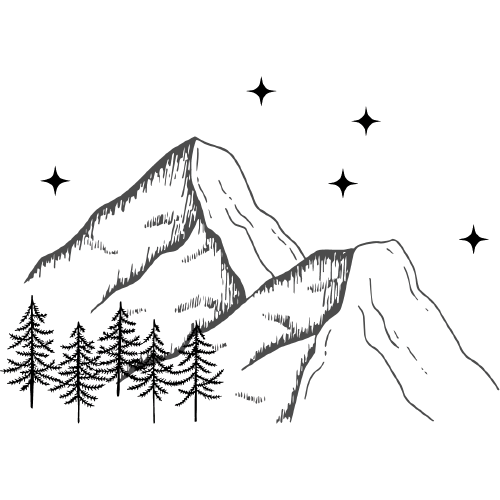20 Helpful Tips for Tent Camping in the Rain
A rainy day can interfere with camping trips, but it doesn’t have to!
While rain can dampen your dreams of making s’mores and staring up at the stars, there are plenty of measures that campers can take to ensure that camping in the rain is still a pleasant experience.
Use these tips for camping in the rain to have a fun and comfortable camping trip no matter the weather.
Camping in the rain just requires a few extra considerations compared to camping in sunny weather. I’ve divided these tips into steps to take before, during, and after the camping trip.
Once you’ve mastered these tips, you’ll never consider canceling your plans because of a little rain.
Tips to prep for a rainy camping trip
The best way to handle a rainy camping trip is to be prepared for it ahead of time. Here are some steps you should take before heading to the campsite in order to be ready when it rains.
1. Buy a tent with a long rainfly
Many inexpensive tents come with a very short rainfly.
These rainflies barely cover the top of the tent and don’t do much to keep the tent dry.
Ideally, the rainfly should come down as close to the ground as possible to cover more of the tent in the event of rain.
It’s even better if the tent comes with a vestibule to cover some space outside of the tent. This makes it easy to store shoes and other gear outside of the tent while keeping them dry.
Investing in a tent with a sufficient rainfly and/or vestibule is completely worth it if you plan to camp often.
Related: The Best Time to Buy a Tent
2. Check the detailed weather forecast
Look up the hourly forecast or weather radar to get a rough sense of when the rain will occur during your camping trip.
For instance, will it rain for one afternoon? Overnight? During the whole trip?
This will help set expectations that you can plan around. Just remember that rain can be unpredictable and vary from the forecast, so be mentally prepared for anything.
Make sure to check the weather forecast as close to the camping trip as possible. This will be the most accurate prediction since forecasts change frequently.
Don’t wait to check when the rain will pass as it’s happening because you likely won’t have cell service to check the weather once you’re at the campground.
3. Be prepared with rainy day activities
Traditional camping activities like sitting around a campfire aren’t always feasible or pleasant on a rainy day.
But the rain can’t ruin all your fun if you’re prepared with rain-friendly camping activities.
Keep these activities in the back of your mind so you’re ready to start them as soon as the rain starts. Then there won’t be any interruptions to your fun!
Make sure to pack any entertainment you may desire like books, notepads, and a deck of cards. It’s only helpful to remember these rainy day activities if you actually bring the right things on your camping trip!
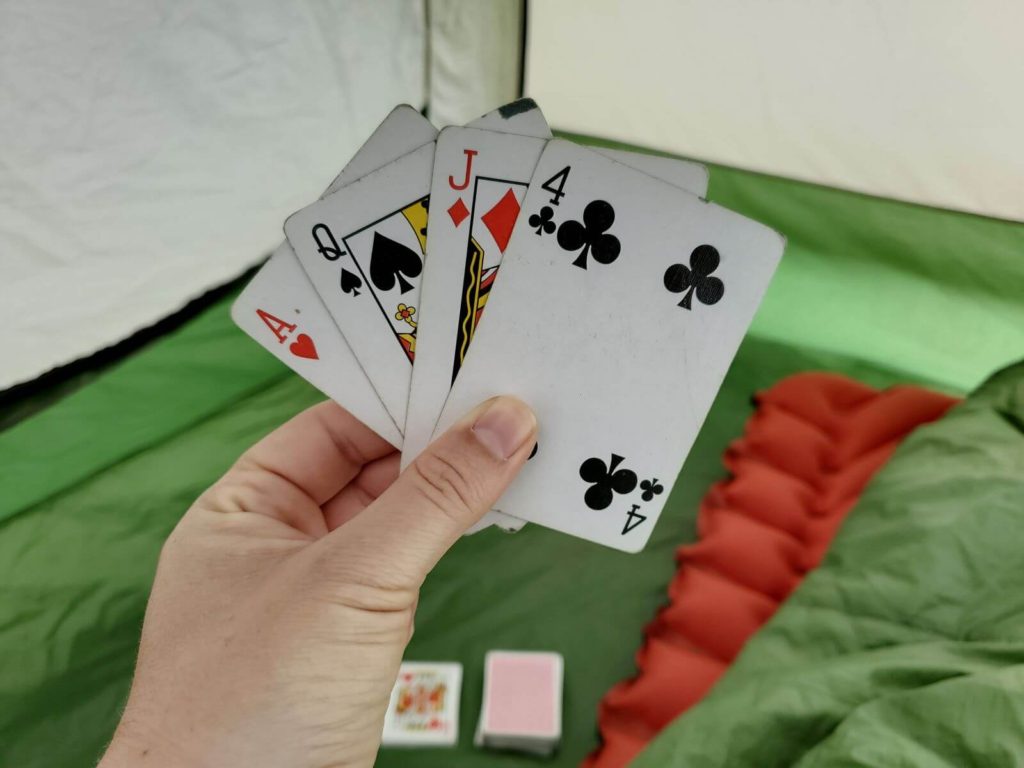
4. Pack a canopy
Depending on how large your tent is, it may not be a comfortable place to hide from the rain for long periods of time.
My two-person tent is barely large enough to do more than sleep or sit up in. I would only be able to enjoy reading or playing cards in such a cramped position for so long.
A canopy allows you to create a small, dry “living room” to hang out under at the campsite.
The space under the canopy can be used to stay dry while eating, playing games, and just taking in the great outdoors.
Having this dry space available can be a game changer on a rainy day.
5. Pack foods that don’t require cooking
Sometimes it’s just too rainy to cook outdoors.
You don’t want to be in a position where you don’t have anything to eat because all of the food you bought needs to be cooked.
Make sure to pack no-cook foods like overnight oats, granola bars, and dried fruit.
These foods may not be as appealing as a fresh, hot meal, but they certainly keep you fueled in a pinch.
6. Pack synthetic and wool clothing
Not all clothing is the same when it comes to being outside in the rain.
Cotton will absorb the rain and takes a long time to dry. This makes cotton clothing uncomfortable to wear in the rain.
It’s better to wear clothing made from wool or synthetic materials like polyester. These materials are better at wicking moisture than cotton is.
If you own clothes that are made of wool or synthetic materials, opt for packing those when there’s rain in the forecast.

7. Pack extra clothing
No matter what material your clothes are made out of, they’re not going to dry instantly.
The only way to quickly get relief from wet clothing is to have a dry set of clothes on hand to change into.
It’s especially helpful to have a dry set of clothing to change into before you go to sleep. If you go to sleep with wet clothing on, you’ll get the inside of your sleeping bag and tent wet, too.
These can be harder to dry out and will just create cold, miserable sleeping conditions.
Pack more clothing than you might normally pack for a camping trip when the forecast calls for rain.
8. Pack a tarp (or two)
Tarps are an all-purpose tool that can be incredibly helpful to have when you’re camping in the rain.
They can be used to keep pretty much anything dry.
Toss a tarp over a pile of firewood or tie one up for an extra layer of protection over your tent. Tarps can also be used to make a DIY canopy over a picnic table.
Just make sure to bring some cord or rope if you plan to tie up tarps for shelter from the rain.
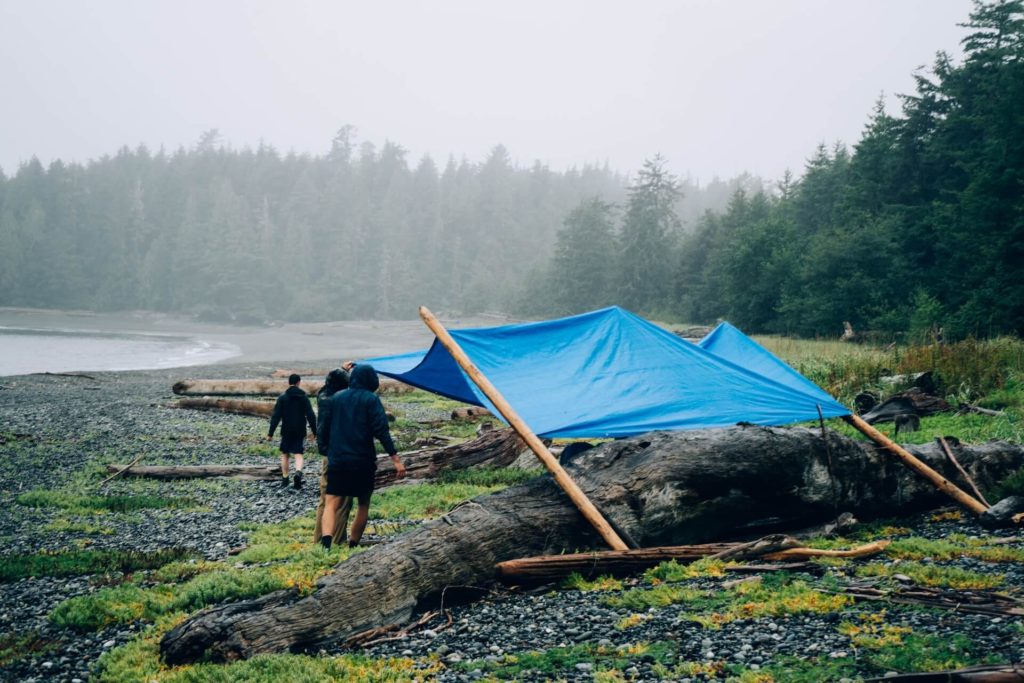
9. Pack extra trash bags
Trash bags are another item that can serve multiple purposes during a rainy camping trip.
I pack extra trash bags every time it might rain on my camping trip. My tent doesn’t have a vestibule to keep items dry outside of the tent, so instead of keeping my shoes outside in the rain, I use trash bags to set my wet shoes on inside the tent.
Trash bags can also be used to separate wet items from dry items when you’re packing up.
It’s a small tip that can prevent water from getting everywhere, keeping you more comfortable (and sane!) during your camping trip.
Tips to use during a rainy camping trip
Here are tips to implement once you’re already at the campsite.
10. Consider tent placement
Where you place your tent within your campsite can make a difference when it comes to rain.
This is not relevant if your campsite has a designated tent pad to set up your tent on. But if you have a choice of where to put your tent, there are a few factors to consider.
If the campsite isn’t flat, look for a spot that’s up high to prevent water from flowing down into your tent. Avoid areas where puddles may form.
Also consider where trees are spaced around the campsite. Trees may provide some cover compared to a spot that’s exposed to the open sky. But on the other hand, the tree branches may continue to drip and the tent will be slower to dry than if it was exposed to the sun.
If it’s very stormy, trees can also pose a hazard since branches could fall down onto the tent.
No matter what position is the best place for the rain, make sure to pick a spot with a durable surface in order to leave no trace.
11. Put the rainfly on your tent
Owning a rainfly is not enough to keep your tent dry in the rain.
The rain fly is completely useless if you don’t use it!
Set up your rainfly over your tent every time you go camping.
It can be tempting to leave the rainfly off to increase ventilation or to see the stars at night.
But rain can be unpredictable. It’s better to already have the rainfly on your tent when you need it.
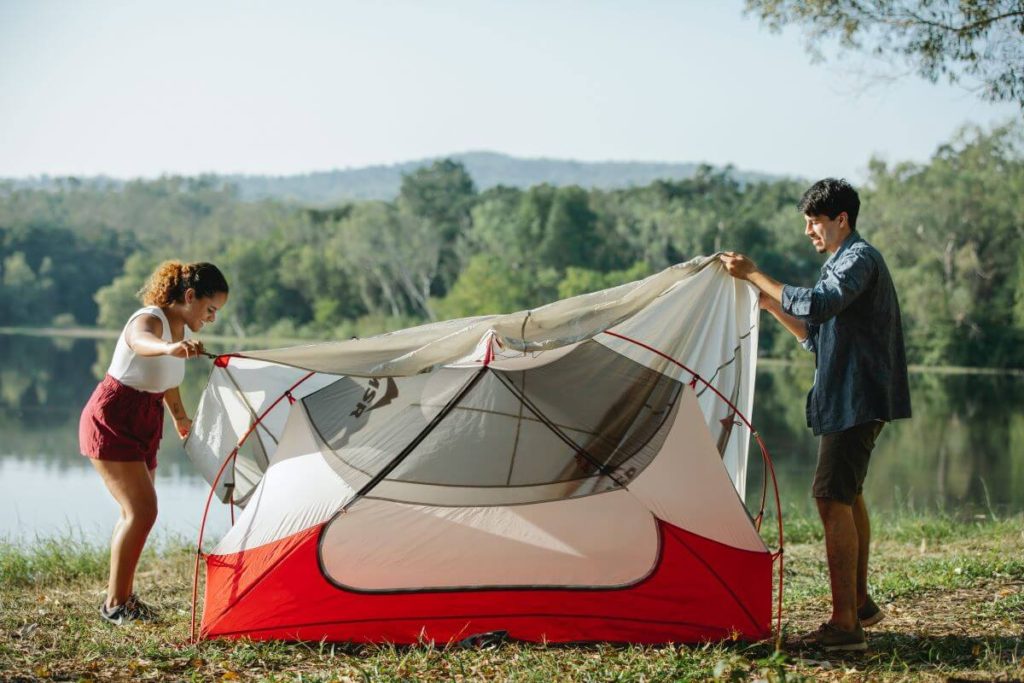
12. Keep firewood dry
Keeping a stash of firewood dry during the rain makes it much easier to start a campfire after the rain passes.
If you’re car camping, store kindling and firewood in or under your vehicle to keep it in a dry place no matter the weather.
Firewood can also be stored under a tarp or canopy for safe keeping.
If you remember to keep your firewood out of the rain, you just might get to make s’mores after all.
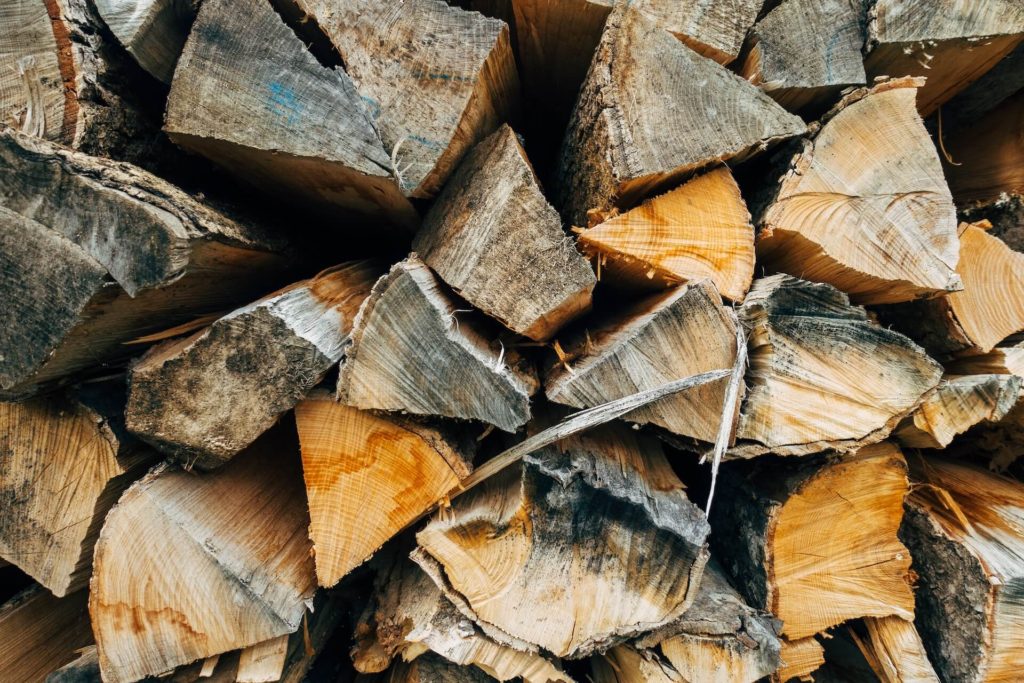
13. Cook with a propane stove
Some campers love the idea of cooking over a campfire or on a grill.
I always advocate for cooking with a propane camping stove instead.
Not only does a stove give you more control over the cooking process, but it is also easier to use in a variety of weather conditions.
Relying on a campfire to make camping meals is risky since it may be difficult to keep a fire lit after the rain. If the fire pit is too wet or you forget to keep a stash of firewood in a dry place, the camping stove will still work.
Just remember that a propane stove should never be used in an enclosed space like a tent. Propane stoves must be used in a well-ventilated area to prevent carbon monoxide poisoning.

14. Keep items away from the interior walls of the tent
If your rain fly doesn’t go all the way down to the ground, part of your tent will be exposed to rain.
Rain may seep through those exposed parts of the tent wall. This may not be enough rain to fill the floor of your tent with water, but anything that touches the wet tent walls will also get wet.
My rainfly covers all but a few inches at the bottom of my tent. When my sleeping bag bumps up against the bottom of the tent walls, my sleeping bag gets wet.
Keep any items in your tent away from the walls so they stay dry in the event of rain.
15. Zip up tent windows during the rain
As with a rainfly, it may be tempting to leave tent windows open for views and ventilation.
But unzipped windows can let rain into the tent.
This is especially true if your rain fly doesn’t fully cover up the tent doors. In this case, the windows may be exposed to the rain so open windows will let the rain right inside.
Keep tent windows zipped closed while the rain is coming down in order to prevent rain from coming in.
16. Don’t dry out clothing next to the campfire
Once the rain passes and you can light a campfire, it may seem like a good idea to dry out your clothes near the fire.
I don’t recommend putting any wet clothes or shoes near a campfire to dry them out.
I’ve gone camping with a friend who put wet shoes next to the campfire only to have them melt.
It still takes long enough for clothes to dry next to a campfire that they’re likely to burn or melt in the process.
Just let clothes air dry if they got wet in the rain.
17. Watch for sources of flooding
It’s one thing to have some rain fall on your campsite.
But if you’re camping near a river or other body of water, rain may cause it to flood and pose additional hazards.
The flooding may be enough to run into your campsite or make driving around the campsite difficult.
Be aware of any bodies of water near your campsite in the event that rainfall is heavy and causes flooding.
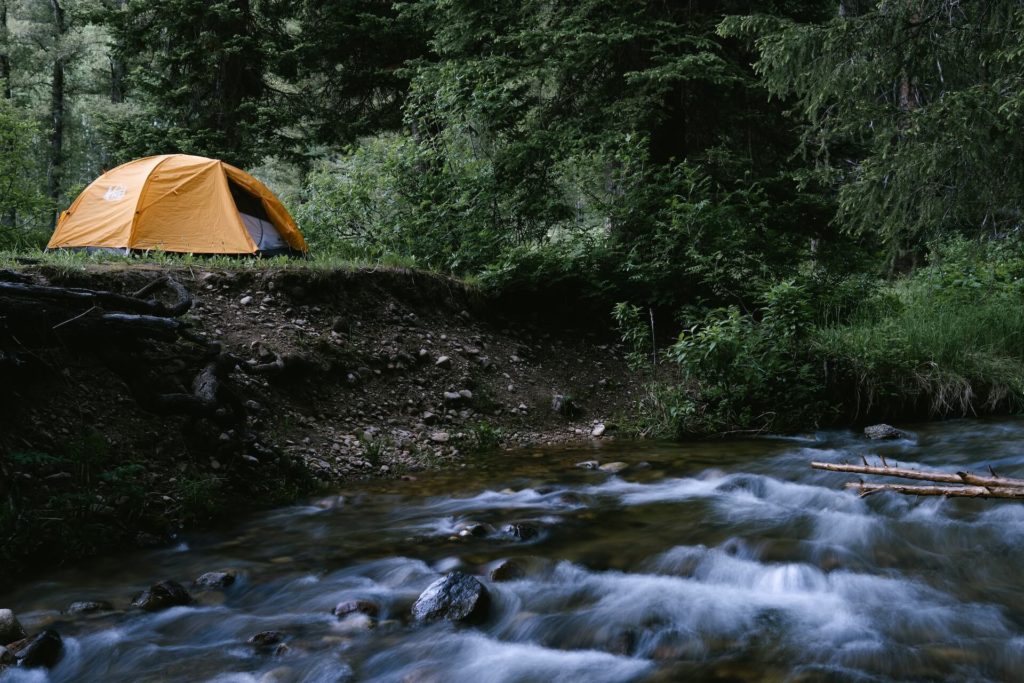
18. Embrace the rain
Camping in the rain is only miserable if you try to avoid the rain entirely.
But if you embrace the rain, you can still enjoy plenty of activities.
Remember: it’s just water! Anything that gets wet will dry off eventually.
Plus, you’ll have to face the rain eventually if you plan to emerge from your tent to use the bathroom. Accept that it’s ok to spend time in the rain and you’ll have a much better attitude about it.
Tips to remember after a rainy camping trip
You survived camping in the rain, but you’re not in the clear yet. There are a couple of steps to take after a rainy camping trip in order to keep your gear in tip top shape.
19. Dry out your tent when you return home
Your tent may still be wet when it’s time to pack up the campsite and go home.
It’s important to air out your tent and let it dry completely once you get home.
Trust me: you don’t want to store your tent when it’s still wet.
Learn from my mistake.
I once packed my tent away wet at the end of the season so it sat in its bag for months without being able to dry out. When I took out my tent the following year, the rainfly was covered in mildew.
It was a major pain to clean the rainfly even when I used cleaning supplies specifically designed for this scenario.
You can bet that letting my tent dry out before storing it will never slip my mind again.
20. Waterproof your gear regularly
Gear like tents and rain jackets come with water repellent coatings on them.
But this water repellent coating can break down over time.
Apply a water repellant that’s specifically designed for gear each year or as needed. These products can come in different forms such as a spray or a liquid to add in the laundry.
Reapplying a water-resistant coating to your gear keeps it ready to hold up on those rainy camping days.
More Camping Tips
- 40 Fun Rainy Day Camping Activities (For All Ages)
- Camping And Hiking On A Budget: 8 Ways To Save Money On Your Next Outdoor Adventure
- Camping Cookbooks For A Variety Of Camping Styles And Diets
- Zero Waste Camping Tips: 5 Ways To Reduce Waste On Camping Trips
- Where To Rent Camping Gear (Anywhere In The US)
- The Best Time to Buy a Tent
As always, enjoy the outdoors responsibly. Leave no trace on all of your adventures.
